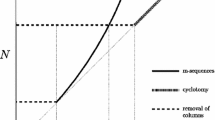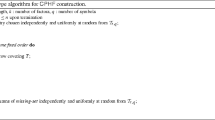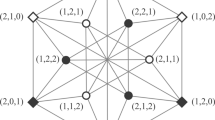Abstract
For a prime power \({q \equiv 1 (mod{v})}\) , the q × q cyclotomic matrix, whose entries are the discrete logarithms modulo v of the entries in the addition table of \({\mathbb{F}_q}\) , has been shown using character theoretic arguments to produce an \({\varepsilon}\) -biased array, provided that q is large enough as a function of v and \({\varepsilon}\) . A suitable choice of \({\varepsilon}\) ensures that the array is a covering array of strength t when \({q > t^2 v^{4t}}\) . On the other hand, when v = 2, using a different character-theoretic argument the matrix has been shown to be a covering array of strength t when \({q > t^2 2^{2t-2}}\) . The restrictions on \({\varepsilon}\) -biased arrays are more severe than on covering arrays. This is exploited to prove that for all v ≥ 2, the matrix is a covering array of strength t whenever \({q > t^2 v^{2t}}\) , again using character theory. A number of constructions of covering arrays arise by developing and extending the cyclotomic matrix. For each construction, extensive computations for various choices of t and v are reported that determine the precise set of small primes for which the construction produces a covering array. As a consequence, many covering arrays are found when q is smaller than the bound \({t^2 v^{2t}}\) , and consequences for the existence of covering arrays reported.
Similar content being viewed by others
References
Ananchuen W., Caccetta L.: On the adjacency properties of Paley graphs. Networks 23(4), 227–236 (1993)
Azar J., Motwani R., Naor J.: Approximating probability distributions using small sample spaces. Combinatorica 18, 151–171 (1998)
Blass A., Exoo G., Harary F.: Paley graphs satisfy all first-order adjacency axioms. J. Graph Theory 5(4), 435–439 (1981)
Bollobás B.: Random Graphs. Academic Press Inc., London (1985).
Chateauneuf M.A., Kreher D.L.: On the state of strength-three covering arrays. J. Combin. Des. 10(4), 217–238 (2002)
Cohen M.B., Colbourn C.J., Ling A.C.H.: Constructing strength three covering arrays with augmented annealing. Discrete Math. 308, 2709–2722 (2008)
Colbourn C.J.: Combinatorial aspects of covering arrays. Le Matematiche (Catania) 58, 121–167 (2004)
Colbourn C.J.: Covering array tables. http://www.public.asu.edu/~ccolbou/src/tabby, 2005—present.
Colbourn C.J.: Distributing hash families and covering arrays. J. Combin. Inf. Syst. Sci. (to appear).
Colbourn C.J., Kéri G.: Covering arrays and existentially closed graphs. Lect. Notes Comput. Sci. 5557, 22–33 (2009)
Colbourn C.J., Martirosyan S.S., van Trung T., Walker R.A. II: Roux-type constructions for covering arrays of strengths three and four. Des. Codes Cryptogr. 41, 33–57 (2006)
Forbes M., Lawrence J., Lei Y., Kacker R.N., Kuhn D.R.: Refining the in-parameter-order strategy for constructing covering arrays. J. Res. Nat. Inst. Stand. Tech. 113(5), 287–297 (2008)
Skipper D.E., Skipper D.E., Skipper D.E., , : t-covering arrays: upper bounds and Poisson approximations. Comb. Probab. Comput. 5, 105–118 (1996)
Graham R.L., Spencer J.H.: A constructive solution to a tournament problem. Canad. Math. Bull. 14, 45–48 (1971)
Hartman A.: Software and hardware testing using combinatorial covering suites. In: Golumbic M.C., Hartman I. B.-A. (eds.) Interdisciplinary Applications of Graph Theory, Combinatorics, and Algorithms, pp. 237–266. Springer, Norwell, MA (2005).
Hedayat A.S., Sloane N.J.A., Stufken J.: Orthogonal Arrays. Springer, New York (1999)
Katona G.: Two applications (for search theory and truth functions) of Sperner type theorems. Periodica Math. 3, 19–26 (1973)
Kleitman D., Spencer J.: Families of k-independent sets. Discrete Math. 6, 255–262 (1973)
Lidl R., Niederreiter H.: Finite Fields, 2nd edn. Cambridge University Press, Cambridge (1997)
Martirosyan S.S., Colbourn C.J.: Recursive constructions of covering arrays. Bayreuth. Math. Schr. 74, 266–275 (2005)
Martirosyan S.S., van Trung T.: On t-covering arrays. Des. Codes Cryptogr. 32(1–3), 323–339 (2004)
Nayeri P., Colbourn C.J., Konjevod G.: Randomized postoptimization of covering arrays. Lect. Notes Comput. Sci. 5874, 408–419 (2009)
Schmidt W.M.: Equations over finite fields. An elementary approach. Lecture Notes in Mathematics, vol. 536. Springer, Berlin (1976).
Sherwood G.B., Martirosyan S.S., Colbourn C.J.: Covering arrays of higher strength from permutation vectors. J. Combin. Des. 14(3), 202–213 (2006)
Author information
Authors and Affiliations
Corresponding author
Additional information
Communicated by Ron Mullin/Rainer Steinwandt.
To Spyros Magliveras on his Seventieth Birthday.
Rights and permissions
About this article
Cite this article
Colbourn, C.J. Covering arrays from cyclotomy. Des. Codes Cryptogr. 55, 201–219 (2010). https://doi.org/10.1007/s10623-009-9333-8
Received:
Accepted:
Published:
Issue Date:
DOI: https://doi.org/10.1007/s10623-009-9333-8




